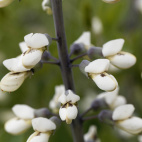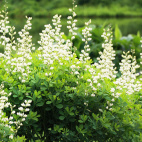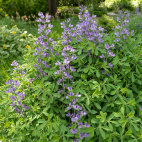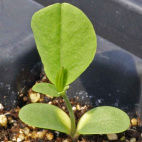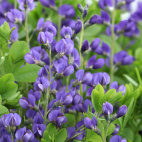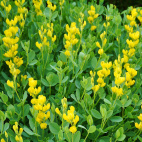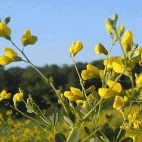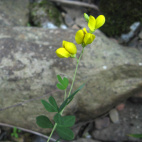Cream Wild Indigo Seeds
- HOW TO GROW
- FAST FACTS
- REVIEWS
HOW TO GROW
Sowing: Since this plant does not transplant well, it should be direct sown. The seed will need to be scarified; to accomplish this, pour 150 degrees F water over the seed and let it soak overnight the day before planting. In late fall, plant the cream wild indigo seeds 1/2" deep. For spring planting, the scarified seed will need to be mixed with moist sand and stored in the refrigerator for 10 days before planting. Germination should take place within 15-20 days.
Growing: This plant tolerates clay, gravel, and sand and can also thrive in poor soil. It tolerates drought well, but it also benefits from occasional watering. Though long-lived, the plants develop slowly and may not flower until their second or third season. The foliage may be pruned for neat growth after blooming, though this will prevent the development of the seed pods. The plant will go dormant over winter, and can be cut down to 6" after the foliage dies. Eventually, the plants will spread by rhizomes. White Wild Indigo is a host plant for the Indigo Dusky Wing and Zarucco Dusky Wing butterflies, though the foliage can be fatal to grazing animals.
Harvesting: The foliage and seed pods of this flower both dry well and make attractive additions to dried flower arrangements.
Seed Saving: When ripe, the seed pods will turn black; cut them off and spread them out to dry away from direct sunlight. Split the pods open to remove the Baptisia Leucophaea seeds. Store cream wild indigo seeds in a cool, dry place.
FAST FACTS
Common Names: Buffalo Pea False Indigo, Cream False Indigo, Black Rattlepod
Latin Name: Baptisia leucophaea
Species Origin: US Native Wildflower
Type: Native Wildflowers
Life Cycle: Perennial
USDA Zones: 4, 5, 6, 7, 8, 9, 10
US Regions: Plains/Texas, Midwest, Southeast
Seeds per Ounce: 2,300
Stratification: Cold/Wet for 1 Week
Germination Ease: Stratify 1 Week
Sunlight: Full Sun, Part Sun
Height: 24 Inches
Color: Cream
Bloom Season: Blooms Late Spring
Uses: Attracts Pollinators, Attracts Honeybees, Attracts Butterflies, Cut Flowers, Deer Resistant
Just the plant I needed
I started a Hugelkultur bed a couple of years ago as a pollinator garden, but I think it ended up being a little too heavy on carbon which bound up too much nitrogen. Some plants languished and died while others did just ok. A good solution is to pick a nitrogen fixing plant to grow for a couple of years to help while some of the woody debris decays a bit. I decided on Wild Indigo as my nitrogen fixer because I love the flowers and it will go well in my pollinator garden.
DESCRIPTION

HOW TO GROW
Sowing: Since this plant does not transplant well, it should be direct sown. The seed will need to be scarified; to accomplish this, pour 150 degrees F water over the seed and let it soak overnight the day before planting. In late fall, plant the cream wild indigo seeds 1/2" deep. For spring planting, the scarified seed will need to be mixed with moist sand and stored in the refrigerator for 10 days before planting. Germination should take place within 15-20 days.
Growing: This plant tolerates clay, gravel, and sand and can also thrive in poor soil. It tolerates drought well, but it also benefits from occasional watering. Though long-lived, the plants develop slowly and may not flower until their second or third season. The foliage may be pruned for neat growth after blooming, though this will prevent the development of the seed pods. The plant will go dormant over winter, and can be cut down to 6" after the foliage dies. Eventually, the plants will spread by rhizomes. White Wild Indigo is a host plant for the Indigo Dusky Wing and Zarucco Dusky Wing butterflies, though the foliage can be fatal to grazing animals.
Harvesting: The foliage and seed pods of this flower both dry well and make attractive additions to dried flower arrangements.
Seed Saving: When ripe, the seed pods will turn black; cut them off and spread them out to dry away from direct sunlight. Split the pods open to remove the Baptisia Leucophaea seeds. Store cream wild indigo seeds in a cool, dry place.
FAST FACTS
Common Names: Buffalo Pea False Indigo, Cream False Indigo, Black Rattlepod
Latin Name: Baptisia leucophaea
Species Origin: US Native Wildflower
Type: Native Wildflowers
Life Cycle: Perennial
USDA Zones: 4, 5, 6, 7, 8, 9, 10
US Regions: Plains/Texas, Midwest, Southeast
Seeds per Ounce: 2,300
Stratification: Cold/Wet for 1 Week
Germination Ease: Stratify 1 Week
Sunlight: Full Sun, Part Sun
Height: 24 Inches
Color: Cream
Bloom Season: Blooms Late Spring
Uses: Attracts Pollinators, Attracts Honeybees, Attracts Butterflies, Cut Flowers, Deer Resistant
Reviews
Review
Just the plant I needed
I started a Hugelkultur bed a couple of years ago as a pollinator garden, but I think it ended up being a little too heavy on carbon which bound up too much nitrogen. Some plants languished and died while others did just ok. A good solution is to pick a nitrogen fixing plant to grow for a couple of years to help while some of the woody debris decays a bit. I decided on Wild Indigo as my nitrogen fixer because I love the flowers and it will go well in my pollinator garden.
Also Consider These:
-
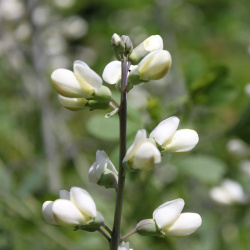 White Wild Indigo Seeds
Baptisia alba
Quick View
x
White Wild Indigo Seeds
Baptisia alba
Quick View
xWhite Wild Indigo Seeds
Starting at $3.75 USD -
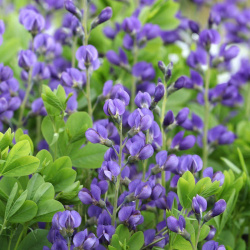 On Sale!
Blue Wild Indigo Seeds
Baptisia australis
Quick View
x
On Sale!
Blue Wild Indigo Seeds
Baptisia australis
Quick View
xBlue Wild Indigo Seeds
Starting at $3.48 USD -
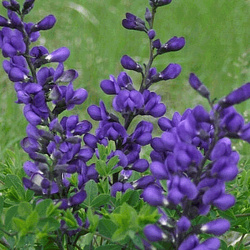 On Sale!
Dwarf Blue Indigo Seeds
Baptisia minor
Quick View
x
On Sale!
Dwarf Blue Indigo Seeds
Baptisia minor
Quick View
xDwarf Blue Indigo Seeds
Starting at $3.48 USD -
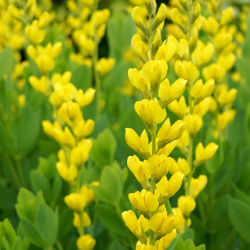 Large Yellow Wild Indigo Seeds
Baptisia sphaerocarpa
Quick View
x
Large Yellow Wild Indigo Seeds
Baptisia sphaerocarpa
Quick View
xLarge Yellow Wild Indigo Seeds
Starting at $3.48 USD -
 Small Yellow Wild Indigo Seeds
Baptisia tinctoria
Quick View
x
Small Yellow Wild Indigo Seeds
Baptisia tinctoria
Quick View
xSmall Yellow Wild Indigo Seeds
Starting at $3.75 USD







